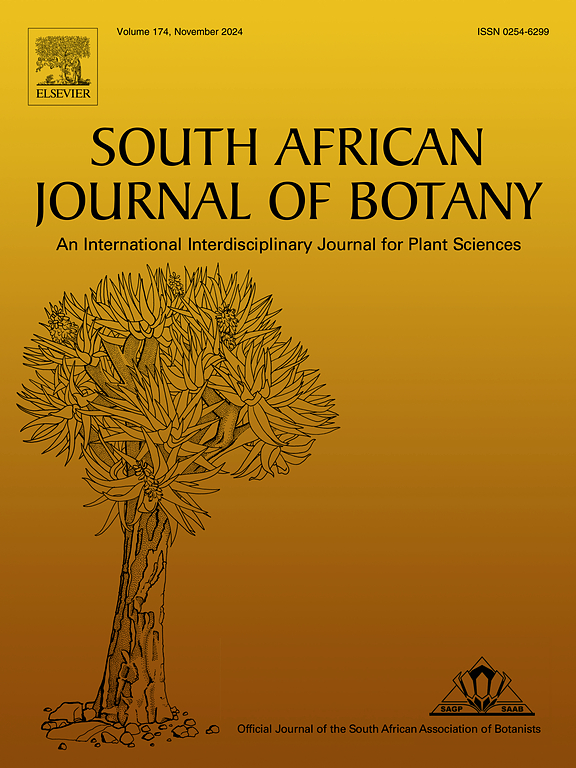日则地区Eğrisap梨(Pyrus communis L.)无性系选择物化特性的测定
IF 2.7
3区 生物学
Q2 PLANT SCIENCES
引用次数: 0
摘要
土耳其位于西亚基因中心,是包括梨在内的许多水果物种的重要遗传中心。里泽是土耳其东北部的一个省,位于安纳托利亚东北部地区,是梨进化发展的遗传中心地区。本研究旨在鉴定具有优良性状的Eğrisap梨克隆基因型,并将其引入经济应用。为此,对日则省及其地区进行了调查,并从预先选定的Eğrisap梨无性系中收集了果实和叶片样品。对这些样品进行了形态学、形态学和化学分析。采用jmp13统计软件包对Eğrisap梨克隆类型进行比较。根据研究结果,各无性系类型的果实形态特征变化如下:果重(99.10-139.54 g)、果宽(54.52-65.41 mm)、果长(57.58-68.83 mm)、果柄长(50.75-59.50 mm)、果柄厚(2.36-2.91 mm)、果心宽(5.15-7.55 mm)、果心长(9.73-14.51 mm)、果肉硬度(3.61-7.13 lb)、种子数(5.30-8.55)、叶宽(45.80-60.04 mm)、叶长(64.53-82.37 mm)、叶柄长(37.04-60.99 mm)、叶柄厚(0.83-1.20 mm)、可溶性固形物含量(SSC)(9.10% - 16.0%)。在化学成分方面,各无性系的pH值为(3.78 ~ 4.22),可滴定酸度为(0.22% ~ 0.47%),蛋白质含量为(1.50% ~ 4.95%),维生素C含量为(0.92 ~ 2.28 mg/100 g),灰分含量为(1.16% ~ 4.30%),总糖含量为(9.66% ~ 17.28%)。矿质元素分析表明,梨品种铁含量为(0 ~ 14.7µg/g)、铜(2.90 ~ 9.12µg/g)、锰(2.9 ~ 11.6µg/g)、镁(321.7 ~ 771.5 mg/g)、锌(0µg/g)、钠(9.6 ~ 39.6µg/g)、钾(5.43 ~ 14.50µg/g)、钙(50.1 ~ 219.7µg/g)、钴(0.01 ~ 0.31µg/g)、镉(0 ~ 0.1µg/g)、镍(0.08 ~ 4.41µg/g)。在日则地区种植的Eğrisap梨无性系中,53型IYD 01具有最优的品质标准和化学成分。因此,建议将该无性系介绍给生产者进行栽培。本文章由计算机程序翻译,如有差异,请以英文原文为准。
Determination of selection-focused physicochemical properties in the local Eğrisap pear (Pyrus communis L.) clone grown in Rize
Turkey, located within the Western Asia gene center, is a significant genetic center for many fruit species, including pears. Rize, a province in the Northeastern part of Turkey, is located within the Northeast Anatolia Region, which falls within the genetic center area where pears have undergone evolutionary development. This study aimed to identify promising local Eğrisap pear clone genotypes with superior traits and to introduce them into economic use. For this purpose, Rize province and its districts were surveyed, and fruit and leaf samples were collected from pre-selected Eğrisap pear clone types. These samples were subjected to pomological, morphological, and chemical analysis. The JMP 13 statistical software package was used to compare the Eğrisap pear clone types. According to the research results, the pomological and morphological traits of the clone types varied as follows: fruit weight (99.10–139.54 g), fruit width (54.52–65.41 mm), fruit length (57.58–68.83 mm), fruit stem length (50.75–59.50 mm), fruit stem thickness (2.36–2.91 mm), core width (5.15–7.55 mm), core length (9.73–14.51 mm), flesh firmness (3.61–7.13 lb), seed number (5.30–8.55), leaf width (45.80–60.04 mm), leaf length (64.53–82.37 mm), petiole length (37.04–60.99 mm), petiole thickness (0.83–1.20 mm), and soluble solid content (SSC) (9.10 %-16.0 %). Regarding chemical composition, the pH values of the clone types ranged from (3.78–4.22), titratable acidity (0.22 %-0.47 %), protein content (1.50 %-4.95 %), vitamin C content (0.92–2.28 mg/100 g), ash content (1.16 %-4.30 %), and total sugar content (9.66 %-17.28 %). Mineral element analysis of the local pear varieties revealed that iron content ranged from (0–14.7 µg/g), copper (2.90–9.12 µg/g), manganese (2.9–11.6 µg/g), magnesium (321.7–771.5 mg/g), zinc (0 µg/g), sodium (9.6–39.6 µg/g), potassium (5.43–14.50 µg/g), calcium (50.1–219.7 µg/g), cobalt (0.01–0.31 µg/g), cadmium (0–0.1 µg/g), and nickel (0.08–4.41 µg/g). Among the local Eğrisap pear clones grown in Rize, clone type 53 IYD 01 was identified as having the most superior quality criteria and chemical composition. Consequently, it is recommended that this clone type be introduced to producers for cultivation.
求助全文
通过发布文献求助,成功后即可免费获取论文全文。
去求助
来源期刊

South African Journal of Botany
生物-植物科学
CiteScore
5.20
自引率
9.70%
发文量
709
审稿时长
61 days
期刊介绍:
The South African Journal of Botany publishes original papers that deal with the classification, biodiversity, morphology, physiology, molecular biology, ecology, biotechnology, ethnobotany and other botanically related aspects of species that are of importance to southern Africa. Manuscripts dealing with significant new findings on other species of the world and general botanical principles will also be considered and are encouraged.
 求助内容:
求助内容: 应助结果提醒方式:
应助结果提醒方式:


